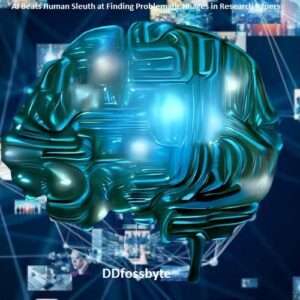In the realm of academic research, the meticulous scrutiny of images plays a pivotal role in ensuring the integrity of scientific studies. For years, this responsibility has primarily rested on the shoulders of human reviewers. However, a groundbreaking development in the world of artificial intelligence has recently shifted the landscape.

With an uncanny ability to detect problematic images in research papers, AI has emerged as a formidable contender, challenging the conventional methods employed by human sleuths.
The Traditional Human Sleuths
Historically, the task of scrutinizing images within research papers fell to human experts. These meticulous individuals painstakingly reviewed countless images to identify inconsistencies, manipulations, or inaccuracies. Their expertise and discerning eyes were instrumental in upholding research integrity. However, this process was often time-consuming and susceptible to human error, leaving room for potential oversights.

The Rise of AI in Image Analysis
Enter artificial intelligence, a technological marvel that has revolutionized image analysis in research papers. AI algorithms, particularly deep learning models, have been trained on vast datasets to recognize the telltale signs of image manipulation or anomalies. This newfound capability has raised the bar for image integrity assessment.
- Speed and Efficiency
One of the most significant advantages of AI in this context is its speed and efficiency. AI algorithms can process and analyze vast quantities of images in a fraction of the time it would take a human reviewer. This accelerated pace is a game-changer in the fast-paced world of scientific research.
- Consistency and Precision
AI offers unparalleled consistency and precision in image analysis. Unlike humans who may vary in their interpretations or miss subtle irregularities, AI maintains a consistent level of scrutiny across all images. It can detect even the most minute discrepancies that might elude human observation.
- Continuous Learning
AI systems have the capacity to learn and adapt continually. As they encounter more images and anomalies, their ability to identify problematic patterns improves over time. This means that AI’s performance in image analysis only gets better with each assessment.
The Implications for Research Integrity
The introduction of AI into the realm of image analysis has profound implications for research integrity. By swiftly and accurately identifying flawed images, AI helps safeguard the credibility of scientific studies. It not only reduces the likelihood of unintentional errors but also acts as a deterrent against deliberate image manipulation.
The Human-AI Synergy
While AI has demonstrated its prowess in image analysis, it’s essential to recognize that it does not replace human reviewers entirely. Instead, AI complements their efforts. Human expertise remains invaluable for contextual understanding, critical thinking, and nuanced judgment, especially in complex research areas.
The synergy between human sleuths and AI tools can lead to a more robust system of image integrity assessment. Researchers can leverage AI’s efficiency to pre-screen images, allowing human reviewers to focus their attention on cases that require deeper analysis or interpretation.

The researchers then tested the AI system against a group of human sleuths, who were tasked with identifying problematic images in a set of research papers. The AI system outperformed the human sleuths in both terms of accuracy and speed.

In the quest for upholding research integrity, the emergence of AI as a proficient image analyst is a significant milestone. It offers speed, consistency, and precision that were previously unattainable through traditional human methods alone. While AI does not replace the role of human reviewers, it enhances their capabilities, contributing to a more rigorous and reliable evaluation of images in research papers.
As AI continues to evolve and adapt, it is poised to play an increasingly vital role in maintaining the high standards of integrity and credibility that the scientific community relies upon. This marriage of human expertise and AI technology promises a brighter future for the reliability and trustworthiness of research findings in academia.
